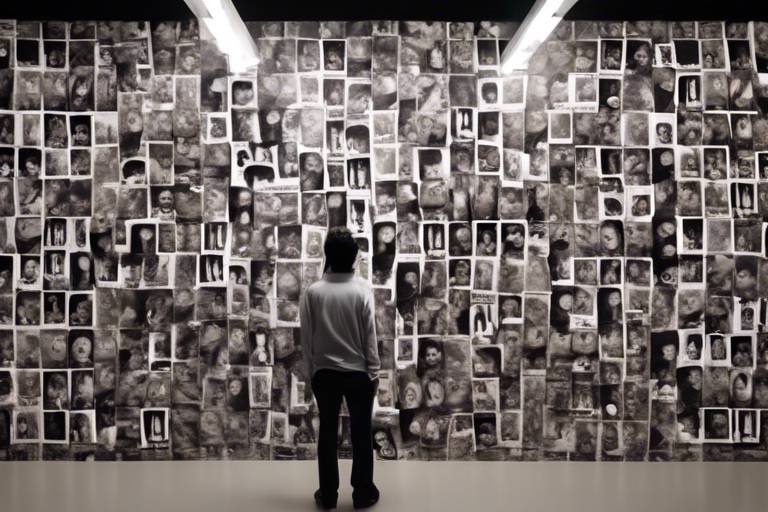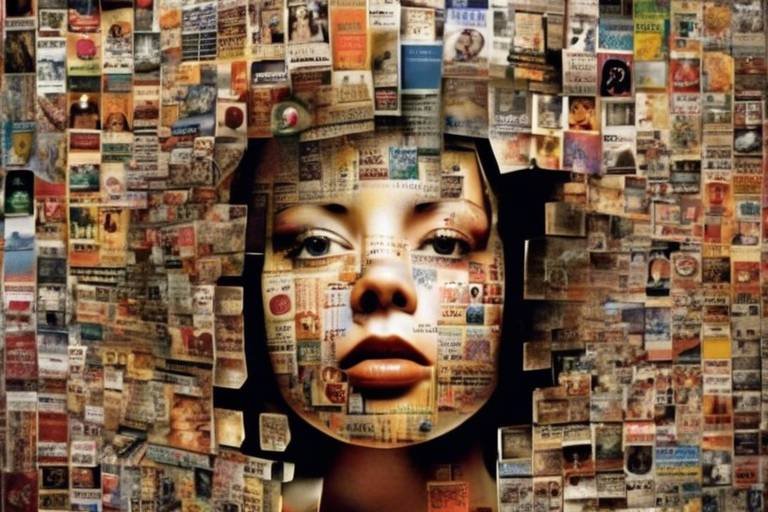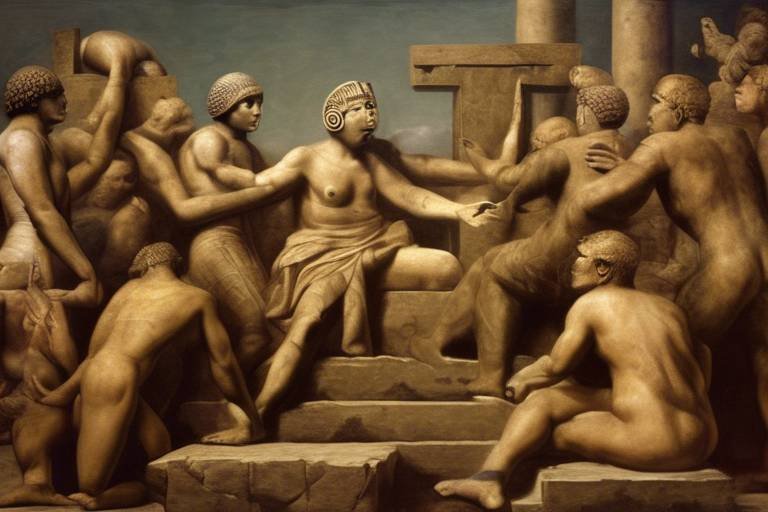The Role of Art in Globalization and Local Identity
Exploring how art serves as a bridge between globalization and local identity, influencing cultural exchange, societal values, and individual expressions in a rapidly changing world.
Art has always been a powerful tool for connecting people across different cultures and backgrounds. It transcends language barriers and geographical boundaries, speaking a universal language of emotions and experiences. Through art, individuals can find common ground, share their stories, and celebrate their differences.
Artists play a crucial role in preserving and reflecting local traditions and identities in the face of globalization. They capture the essence of their communities, showcasing unique perspectives and histories that might otherwise be overshadowed by global influences. In a world where homogenization is a growing concern, art stands as a beacon of diversity and individuality.
In today's digital age, art has taken on new forms and platforms, reaching global audiences with the click of a button. While this digital revolution has expanded the reach of art, it also raises questions about authenticity and cultural appropriation. How do we navigate the fine line between sharing art globally and respecting its cultural roots?
Some artists use their work as a form of resistance against dominant global narratives, reclaiming and asserting local identities and values. They challenge the status quo, pushing back against homogenization and celebrating the richness of cultural diversity. Art becomes a tool for empowerment and self-expression in the face of globalization's pressures.
Artistic collaboration knows no boundaries, with artists coming together from different parts of the world to create unique pieces that blend global influences with local perspectives. These collaborations not only showcase the beauty of cultural exchange but also highlight the interconnectedness of human experiences across the globe.
Art museums serve as hubs of cultural diplomacy, promoting cross-cultural understanding and dialogue through their diverse collections. They offer a space for showcasing artistic traditions from around the world, fostering connections and mutual respect among visitors. Museums become bridges between different cultures, inviting people to explore and appreciate the richness of global artistic heritage.
Art and cultural events have a significant impact on tourism and local economies, attracting visitors and stimulating economic growth. Cities and regions known for their vibrant arts scenes often draw tourists seeking unique cultural experiences. Art becomes not only a form of expression but also a driver of economic development and global recognition.
Integrating art education into curricula plays a vital role in promoting global citizenship and intercultural competence. By exposing students to diverse artistic traditions and perspectives, education fosters empathy, understanding, and appreciation for cultural differences. Art becomes a tool for building bridges and breaking down barriers in an increasingly interconnected world.

Art as a Cultural Connector
Exploring how art serves as a bridge between globalization and local identity, influencing cultural exchange, societal values, and individual expressions in a rapidly changing world.
Art has a remarkable ability to transcend physical borders and linguistic barriers, acting as a universal language that connects individuals from diverse backgrounds. Through shared emotions, experiences, and values, art serves as a cultural connector, fostering understanding and empathy among people worldwide. Whether it's a painting, a sculpture, or a performance, art has the power to evoke emotions that resonate with individuals regardless of their cultural heritage.

Artistic Expression and Identity
Artistic expression plays a crucial role in shaping and preserving local identities in the face of globalization's homogenizing effects. Artists around the world use their creative work as a means of reflecting the unique traditions, histories, and values of their communities. Through art, they have the power to resist the dominant global narratives that threaten to overshadow local cultures. By infusing their creations with elements specific to their heritage, artists assert their identity and contribute to the rich tapestry of global artistic expression.

Art in the Digital Age
Art in the Digital Age has revolutionized the way we create, consume, and interact with art. The emergence of digital platforms has significantly expanded the reach of artistic expression, allowing artists to showcase their work to a global audience with just a few clicks. This instant accessibility has democratized art in many ways, breaking down traditional barriers to entry and enabling emerging artists to gain recognition beyond their local communities.
However, the digital age has also brought about challenges and complexities to the art world. The ease of sharing and replicating digital art raises questions of authenticity and ownership. How can we ensure that digital artworks are not easily copied or manipulated without the artist's consent? Additionally, the issue of cultural appropriation has become more prominent as digital platforms allow for the widespread dissemination of art across different cultures and contexts.
Despite these challenges, the digital age has opened up new avenues for artistic collaboration and experimentation. Artists can now connect and collaborate with peers from around the world, transcending geographical boundaries to create innovative and boundary-pushing works. Virtual reality, augmented reality, and other digital technologies have also transformed the way we experience art, offering immersive and interactive experiences that were previously unimaginable.

Artistic Resistance to Globalization
Artistic resistance to globalization is a powerful tool for preserving local identities and values in the face of homogenizing global influences. Artists around the world are using their creative expressions to push back against dominant narratives and assert their unique cultural heritage. Through their work, they challenge the forces of globalization that seek to standardize and commodify art, advocating for diversity, authenticity, and individuality.
One way artists resist globalization is by incorporating traditional elements and symbols specific to their local culture into their art. By infusing their work with these distinctive features, they not only celebrate their heritage but also resist the erosion of their cultural identity in the globalized world. This act of resistance serves as a reminder of the richness and complexity of local traditions that deserve recognition and preservation.
Furthermore, artistic resistance to globalization can take the form of social commentary and critique on the negative impacts of globalized systems. Artists often use their platform to shed light on issues such as environmental degradation, social inequality, and cultural appropriation perpetuated by globalization. Through their art, they challenge the status quo and inspire viewers to question the consequences of unchecked globalization.
Collaborative efforts among artists who share similar concerns about the effects of globalization also play a significant role in resistance. By coming together across borders, these artists create collective works that amplify their voices and convey a powerful message of unity in diversity. Through collaborative projects, they showcase the strength of local art scenes and highlight the importance of preserving cultural heritage in the face of globalization's pressures.
In essence, artistic resistance to globalization is a form of cultural activism that empowers artists to reclaim their narratives, challenge dominant paradigms, and assert their right to artistic freedom. By resisting the homogenizing forces of globalization, artists uphold the importance of diversity, individuality, and cultural authenticity in a world that is increasingly interconnected but not devoid of local nuances and expressions.

Artistic Collaboration Across Borders
Artistic collaboration across borders is a dynamic process that transcends geographical limitations, allowing artists to merge diverse cultural influences and perspectives into their work. Through collaboration, artists can create pieces that resonate with global audiences while maintaining the authenticity of their local identity. This exchange of ideas and techniques leads to the emergence of unique artistic expressions that blend the best of both worlds.
Imagine a painter from Italy collaborating with a sculptor from Japan, combining traditional Italian techniques with innovative Japanese design elements to create a masterpiece that reflects both their individual styles and cultural backgrounds. This fusion of artistic visions not only enriches the creative process but also fosters mutual understanding and appreciation between different communities.
Artistic collaboration across borders often challenges conventional boundaries and opens up new possibilities for artistic exploration. It encourages artists to step out of their comfort zones, embrace diversity, and celebrate the richness of cultural exchange. By working together, artists can break down barriers, build bridges, and inspire innovation that transcends national borders.
Furthermore, artistic collaborations serve as a powerful tool for promoting cultural diplomacy and fostering international dialogue. Through joint projects and exhibitions, artists can showcase the beauty and complexity of their respective cultures, sparking meaningful conversations and fostering connections that transcend linguistic and political divides. This exchange of artistic ideas not only promotes cultural exchange but also cultivates a sense of global citizenship and unity among artists and audiences alike.

Art Museums as Cultural Diplomacy
Exploring how art serves as a bridge between globalization and local identity, influencing cultural exchange, societal values, and individual expressions in a rapidly changing world.
Art museums play a crucial role in cultural diplomacy by serving as powerful platforms for showcasing diverse artistic traditions and facilitating cross-cultural understanding. These institutions act as bridges between nations, fostering dialogue and cooperation through the universal language of art.
Through carefully curated exhibitions and cultural programs, art museums promote intercultural dialogue and appreciation, highlighting the richness and diversity of global artistic expressions. Visitors are exposed to a wide array of perspectives, traditions, and narratives, fostering empathy and mutual respect.
Moreover, art museums often serve as meeting points for international collaborations, where artists, curators, and art enthusiasts come together to exchange ideas and experiences. These collaborations transcend geographical boundaries, creating opportunities for cultural exchange and mutual enrichment.
By promoting cultural diplomacy, art museums contribute to building bridges between communities, fostering peace, understanding, and cooperation in an increasingly interconnected world. Through art, these institutions inspire dialogue, challenge perceptions, and celebrate the shared humanity that unites us all.

Art's Influence on Tourism and Local Economies
Art plays a significant role in shaping tourism and local economies, acting as a magnet for visitors and a driver of economic growth. When art is integrated into a region's cultural landscape, it has the power to attract tourists seeking unique experiences and creative inspiration. Artistic events, exhibitions, and installations not only draw in visitors but also contribute to the overall vibrancy and appeal of a destination.
Moreover, art has the ability to stimulate local economies by creating employment opportunities in the creative sector, supporting local artisans, and fostering a thriving arts scene. Cultural festivals, galleries, and public art projects can boost revenue for businesses in the area, from hotels and restaurants to transportation services, enhancing the overall economic vitality of the community.
Art's influence on tourism goes beyond mere attraction, as it also shapes the global perception of a region. A vibrant arts scene can elevate a destination's cultural reputation, positioning it as a hub of creativity and innovation. This positive image not only draws in tourists but also attracts investments and partnerships, further bolstering the local economy and fostering sustainable growth.
Furthermore, art tourism has the potential to create a ripple effect, benefiting various sectors such as hospitality, retail, and entertainment. By showcasing local artists and cultural heritage, destinations can differentiate themselves in a competitive market, offering visitors a rich tapestry of experiences that reflect the essence of the community.
In essence, art's influence on tourism and local economies is multifaceted, intertwining creativity, commerce, and cultural identity to create a dynamic ecosystem that thrives on diversity and innovation.

Art Education for Global Citizenship
Art education plays a crucial role in nurturing global citizenship by fostering intercultural competence, empathy, and understanding among individuals in a rapidly globalizing world. Through art, individuals can explore diverse cultural perspectives, traditions, and values, promoting a sense of interconnectedness and shared humanity.
Art classes provide a platform for students to express themselves creatively, encouraging critical thinking, problem-solving skills, and the ability to communicate ideas visually. By engaging with various art forms, students develop a deeper appreciation for cultural diversity and learn to respect different viewpoints and experiences.
Moreover, art education encourages students to think beyond their immediate surroundings and consider global issues, such as social justice, environmental sustainability, and human rights. Through art projects and discussions, students can reflect on their roles as global citizens and envision positive change in the world.
Art education also promotes collaboration and cooperation among individuals from different cultural backgrounds, fostering a sense of community and mutual respect. By working together on creative projects, students learn to value teamwork, communication, and the exchange of ideas, essential skills for global citizenship in a interconnected world.
Furthermore, art education helps individuals develop a sense of cultural awareness and sensitivity, enabling them to navigate diverse environments with respect and understanding. By studying art from various cultures and time periods, students gain insight into the complexities of human experience and the richness of global heritage.
In conclusion, art education is a powerful tool for promoting global citizenship by encouraging intercultural dialogue, empathy, and appreciation for diverse perspectives. By integrating art into educational curricula, we can nurture a new generation of individuals who are equipped to navigate the complexities of a globalized world with creativity, compassion, and cultural intelligence.
Frequently Asked Questions
- What is the significance of art in the context of globalization?
Art plays a crucial role in bridging globalization and local identity by serving as a cultural connector. It transcends boundaries, languages, and differences, bringing people together through shared emotions, experiences, and values.
- How does art contribute to preserving local traditions and identities?
Artistic expression is a powerful tool for reflecting and preserving local traditions, histories, and identities amidst the influences of globalization. Artists use their work to assert the uniqueness and authenticity of their cultural heritage.
- What challenges does art face in the digital age?
The digital age has revolutionized the dissemination of art, enabling global reach but also raising concerns about authenticity and cultural appropriation. Artists navigate through these challenges while leveraging digital platforms for wider exposure.
- How can art promote cross-cultural understanding?
Art museums and cultural events serve as platforms for cultural diplomacy, fostering dialogue and understanding between diverse communities. By showcasing artistic traditions from around the world, art promotes empathy and appreciation for global diversity.
- Why is art education essential for global citizenship?
Integrating art education into curricula is vital for nurturing intercultural competence, empathy, and understanding in a globalized society. Art encourages critical thinking, creativity, and a deeper appreciation of diverse perspectives.



















